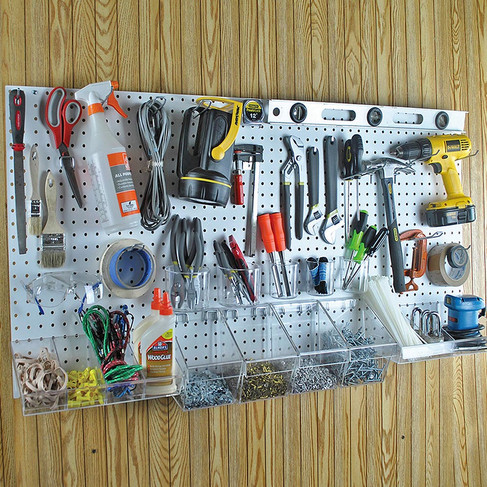Transforming Your Garage: Smart & Simple Organization Strategies
- Garage Door Service

- Oct 28
- 3 min read
Does your garage have more clutter than usable space? You’re not alone—and the good news is you can reclaim it. An organized garage is more than just tidier: it boosts safety, functionality, and even your home’s value. In this blog, we’ll walk you through smart, simple strategies to transform your garage from chaos to clarity.

Step 1 – Assess and Declutter Your Garage
Before you invest in shelving or hooks, you’ve got to clear the ground.
Start by sorting everything into categories: keep, donate/sell, discard.
Be honest about sentimental or “just-in-case” items—truly ask: “When’s the last time I used this?”
Set realistic goals and a timeline. Maybe one weekend for sorting, one evening for throwing out.
Sweep out the space and wipe down surfaces. A fresh visual baseline helps motivate the next steps.
Step 2 – Plan Your Garage Layout
Organizing wisely means designing for use, not just storage.
Zone your garage into functional areas: e.g., tools/workshop, sports and outdoor gear, seasonal storage, and car parking.
With floor space limited, think “what must stay on the floor?” (car, lawn mower) and what can go off-floor (bins, shelves).
For single-car vs. double-car garages: if your car is the priority, aim to keep at least one side largely clear.
Map high traffic vs. long-term storage: items you access often should be easiest to reach.
Step 3 – Choose the Right Storage Solutions
Wall-Mounted Systems
Use pegboards, slatwalls, and hooks for tools, bikes, and shovels. These keep items off the floor and visible.
They’re especially helpful for daily-use items: you can grab and return easily.
Overhead & Ceiling Storage
Use that often-ignored vertical space above. Racks mounted to the ceiling are perfect for seasonal items, large sports gear, or rarely-used boxes.
Safety check: ensure racks are rated for the weight you’ll load and installed securely.
Cabinets & Modular Units
Cabinets give you clean closed-door storage for chemical containers, paints, or items you don’t want visible.
Clear bins and proper labeling help you quickly find what you need.
Consider modular units so you can add or reconfigure later.
Step 4 – Optimize for Daily Use
Create a drop zone near the garage door for things used frequently: backpacks, sports gear, and gardening gloves.
If you use your garage as a workshop or hobby space, build a compact workbench or station with lighting and tool access.
Consider lighting upgrades: better visibility reduces frustration.
Accessibility matters: items used often should be at reachable heights; items rarely used can go higher or further back.
Step 5 – Maintain the Organization
Set aside a short routine: 10 minutes weekly to return items to their homes, label newly added stuff, and reset the space.
Seasonal reassessment: at least twice a year, go through each zone and purge/relocate as needed.
Engage your household: set rules like “everything goes back after use,” and designate bin zones for kids.
Celebrate progress: after the first big purge and reorganization, the maintenance phase is much lighter.
Bonus Tips – Maximize Space Without Remodeling
Use vertical and corner space: corners are often wasted; install tiered shelving or corner racks.
Multi-purpose furniture: e.g., a storage bench doubles as seating and a toy bin, fold-away tables when you need a workspace.
Smart tech ideas: inventory apps or labels to track what’s stored where, QR codes on bins for quick lookup.
Budget-friendly: You don’t need full custom builds. Even smaller changes like adding hooks, clear bins, or overhead racks make a big difference.
Conclusion
From cluttered chaos to clear-functioning space: you’ve got the roadmap. By assessing, planning, choosing smart storage, optimizing for use, and committing to maintenance, you’ll turn your garage into a meaningful part of your home, not just a dumping zone. The benefits: easier mornings, better tool access, safer space, and possibly improved home value. Start small, stay consistent—and enjoy the transformation.
FAQs
Q1: What is the best way to start organizing a messy garage? Start by decluttering: sort items into keep/donate/discard piles, sweep and clean the space, then plan layout and storage zones.
Q2: How can I make a small garage feel bigger? Use vertical storage (walls and ceilings), keep the floor clear, use clear bins so you can see contents, and create designated zones so things aren’t scattered.
Q3: What are the most cost-effective garage storage solutions? Hooks and pegboards, clear plastic bins, overhead ceiling racks, and smart shelving systems all deliver strong value without full remodels.
Q4: How often should I declutter my garage? A quick weekly tidy is great; a deeper seasonal review (2-4 times per year) helps ensure you’re not holding onto unused items.
Q5: Can I DIY garage organization systems safely? Yes—many DIY solutions work well (pegboards, slatwalls, bins). Just check weight ratings for overhead storage, secure installations into studs/joists, and follow safety guidelines when mounting heavy units.













Comments